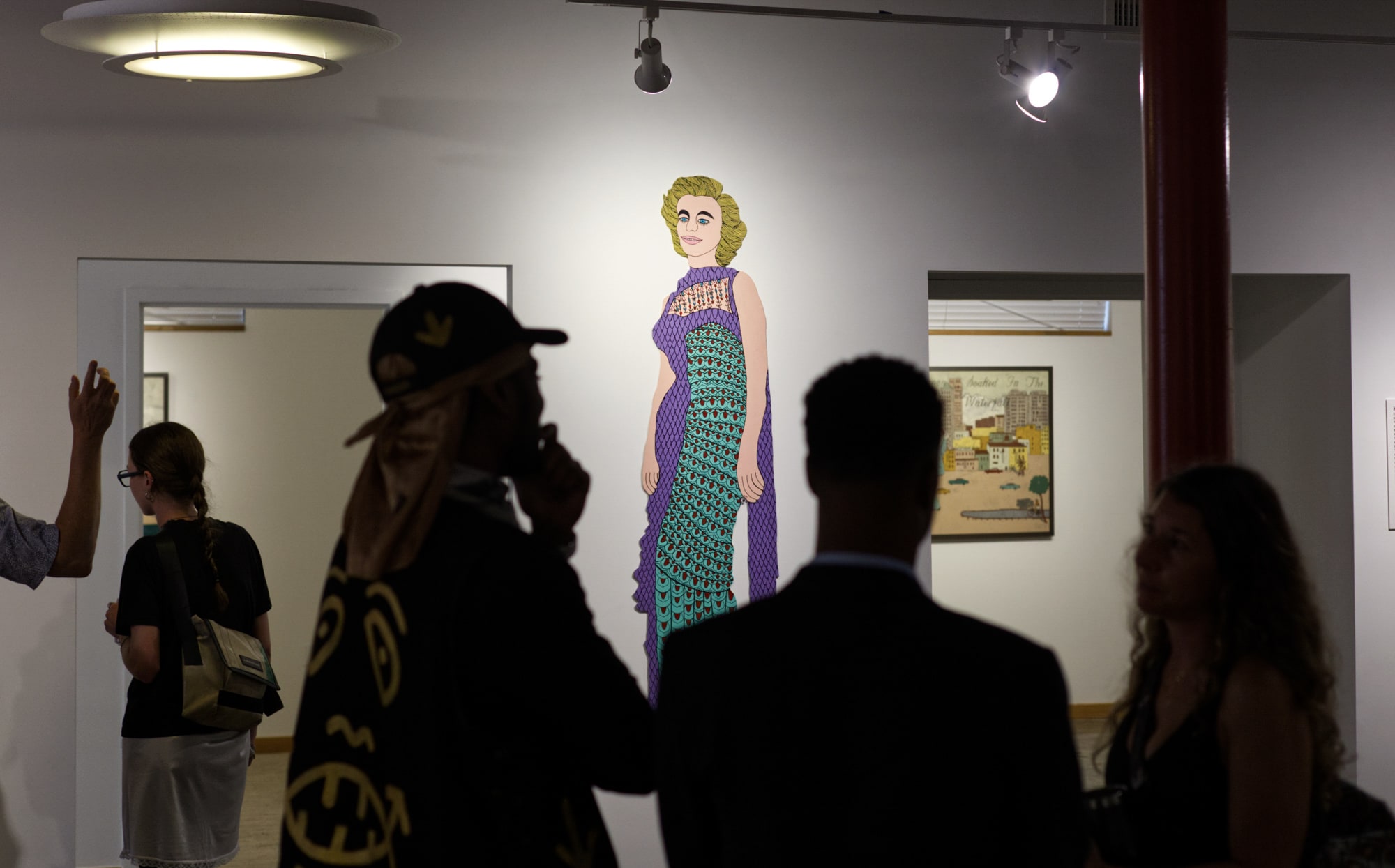
Works by renowned folk artists Howard Finster and Harry Underwood are on view at The Sun ATL through November 15. (Photos by Dustin Timbrook)
"Locate your capacity to love" reads a small graphite inscription in the painting Enraptured by Harry Underwood. It's a concise recommendation swimming in a sea of hand-scribbled prophecy, introspection and sermonizing that makes up The Art of Belief: Howard Finster & Harry Underwood. Currently showing at The Sun ATL, the exhibit presents the work of two artists with diverging ideas about faith who share a conviction in the power of the written word.
The late Georgia folk art legend Howard Finster's prolific output began and ended with the word of God. A loquacious retired Baptist minister, Finster was moved by a spiritual vision at the age of 60 to create "sacred art." Energized by this mandate, the newly ordained artist would go on to make tens of thousands of paintings, sculptures and art objects, often scrawled with his distinctive interpretation of the Gospel.
The Art of Belief presents a mere slice of this incredible catalog, offering a representative sample of Finster's penchant for household materials, heavenly imagery and religious verbosity. Standing in the center of one room in the gallery, the found object piece 3D Pop Coke Bottle is trademark Finster - a giant plastic Coca-Cola bottle elevated from gas station soda cooler to a totem of ministry. See-through plastic becomes a layered, ethereal canvas for a sky full of angels. The world's most recognizable logo serves as the perfect platform for the marker-written exhortation, "Take your burdens to the Lord and leave them there."
"I thought when they put this show together that Finster would be the Christian and I would be the atheist," said Tennessee painter Harry Underwood when asked about his work that is presented alongside Finster's. "But I can't say I'm an atheist. I'm more like a deist or something. Or a Buddhist."
Such ambiguity is the hallmark communication style for Underwood, who from an early age struggled to document his metaphysical notions in a coherent manner. The longer he wrote, the more tangled the ideas became in his head.
"I wish I could just write in a linear way, but I get hung up on all these tangents."
Still, the words kept flooding in, so Underwood spent the '90s channeling them into his home-recorded music, packing every measure with rapid-fire speech. Underwood insists that if you heard those old tapes, you would never want to talk to him again.
"I don't know if I thought like other songwriters do. I thought you should have dense words through your whole song. My songs hardly ever shut up - like being preached a bunch of nonsense from start to finish."
The packaging process for these cassettes was pure photocopy DIY that would ultimately lead to a career in fine art. Underwood assembled pictures with text clipped from magazines, combining and recombining the images and words randomly to generate titles and slogans. Soon he abandoned the magazine clippings in favor of drawing original figures and faces paired with hand-scripted writing. A style began to emerge that would translate perfectly to the gallery: album art without the music.
"That kind of took me the direction that Finster did . . . to have words and pictures."
Underwood writes profundities in short bursts - and he generates a lot of them. He pencils these musings on backdrops of sun-faded, postcard-perfect compositions featuring mid-century motels, beach bodies and Everglades greenery. Working with ordinary latex paints straight from the hardware store shelf, he paints on plywood in neutral color palettes hinting at a DayGlo past.
It's evocative imagery in which visuals often take a backseat to words. Like much of Finster's work, an Underwood painting's true enticement is to be read. Some of these idioms, like "Between the beginning and the end is a good place to be" are accessible. Other passages, such as "A Phenomenon Soaked in the Diary of a Waterfall" are less so. Whether the viewer can make sense of his reflections is beside the point. Unlike Finster, Underwood doesn't necessarily paint to proselytize.
"I'm contemplating philosophy and coming up with my own ideas and figuring out life on the spot," he said.
In true Underwood form, this mixture of meditation and illustration can be contrarily fatalistic or hopeful, vague or immediate. The message of Cataclysm - "Life is established by cataclysm" - suggests a nihilistic worldview where improvement can only emerge from destruction, and yet the words accompany a swimsuited reveler fit for a vintage Florida tourism ad. Is this an ironic juxtaposition? Underwood's genuine nostalgia for his childhood in Miami suggests the opposite: These are idealized representations of human possibility.
"I used to have some recurrent characters I did that were kind of like alter egos of myself . . . that were kind of sad individuals. I outgrew that and I've started to try to make these utopian looking scenes."
To Underwood, utopias are a real possibility within our mortal world. He believes that life can be made perfect by the people living in it. Ironically we find proof of that in the work of Howard Finster who, driven by his conviction that life's greatest reward comes after death, built an actual Paradise Garden out of his former home in Summerville, Georgia, for the living to enjoy.
The Art of Belief: Howard Finster & Harry Underwood will remain on view at The Sun ATL through November 15.
Dustin Timbrook is a creative generalist working in art, film and music. He volunteers on the board of directors for Avondale Arts Alliance. Timbrook loves spending time with his family, playing with dogs and gardening.

